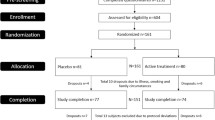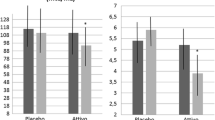Abstract
The aim of this study was to comparatively evaluate the long-term effects of psyllium husk and guar gum supplementation on metabolic syndrome (MS) components. We randomised 141 MS patients to soluble psyllium husk powder or guar gum 3.5 g t.i.d. to be taken 20 min before the main 2 meals, or to a standard diet for a cumulative period of 6 months. Both fibres significantly improved body mass index (−7.2% vs. −6.5%), fasting plasma glucose (−27.9% vs. −11.1%) and insulin (−20.4% vs. −10.8%), HOMA Index (−39.2% vs. −16.7%), glycated haemoglobin (−10.4% vs. −10.3%), low-density lipoprotein cholesterol (−7.9% vs. −8.5%) and apolipoprotein B (−10.5% vs. −5.6%), after 6 months of treatment. Only the psyllium supplementation exerted a significant improvement on plasma triglyceride concentration (−13.3%) and systolic (−3.9%) and diastolic blood pressure (−2.6%). No significant difference was observed regarding the standard diet group in comparison to the baseline. On the basis of our data, psyllium could be more strongly indicated for patients that have to reduce a large number of cardiovascular risk factors, while guar gum could be more rapidly efficacious in strengthening the effect of diets aimed at reducing body weight.
Similar content being viewed by others
References
Pearson TA, Bazzarre TL, Daniels SR et al (2003) American Heart Association guide for improving cardiovascular health at the community level. Circulation 107:645–651
WHO (2003) Population nutrient intake goals for preventing diet-related chronic diseases. In: Diet, nutrition and the prevention of chronic diseases. WHO Technical report Series 916:46–83
Eastwood MA, Passmore R (1983) Dietary fibre. Lancet 2:202–206
Truswell AS (1995) Dietary fibre and plasma lipids. Eur J Clin Nutr 49[Suppl]:S105–S109
Glore SR, Van Treeck D, Knehans AW, Guild M (1994) Soluble fiber and serum lipids: a literature review. J Am Diet Assoc 94:425–436
Kris-Etherton PM, Krummel D, Russell ME et al (1988) The effect of diet on plasma lipids, lipoproteins, and coronary heart disease. J Am Diet Assoc 88:1373–1400
Brown L, Rosner B, Willett WW, Sacks FM (1999) Cholesterol-lowering effects of dietary fiber: a meta-analysis. Am J Clin Nutr 69:30–42
Burke V, Hodgson JM, Beilin LJ et al (2001) Dietary protein and soluble fiber reduce ambulatory blood pressure in treated hypertensives. Hypertension 38:821–826
Sierra M, Garcia JJ, Fernandez N et al (2002) Therapeutic effects of psyllium in type 2 diabetic patients. Eur J Clin Nutr 56:830–842
Anderson JW, Allgood LD, Turner J et al (1999) Effects of psyllium on glucose and serum lipid responses in men with type 2 diabetes and hypercholesterolemia. Am J Clin Nutr 70:466–473
Delargy HJ, O’sullivan KR, Fletcher RJ, Blundell JE (1997) Effects of amount and type of dietary fibre (soluble and insoluble) on short-term control of appetite. Int J Food Sci Nutr 48:67–77
Turnbull WH, Thomas HG (1995) The effect of a Plantago ovata seed containing preparation on appetite variables, nutrient and energy intake. Int J Obes Relat Metab Disord 19:338–342
Landin K, Holm G, Tengborn L, Smith U (1992) Guar gum improves insulin sensitivity, blood lipids, blood pressure, and fibrinolysis in healthy men. Am J Clin Nutr 56:1061–1065
van Nieuwenhoven MA, Kovacs EM, Brummer RJ et al (2001) The effect of different dosages of guar gum on gastric emptying and small intestinal transit of a consumed semisolid meal. J Am Coll Nutr 20:87–91
NCEP expert panel (2001) Expert Panel on detection, evaluation and treatment of high blood cholesterol in adults. Executive summary of the third report of the National Cholesterol Education Program (NCEP) (Adult Treatment Panel III). JAMA 285:2486–2497
Kraus RM, Eckel RH, Howerd B et al (2000) AHA Dietary Guidelines: revision 2000. A statement for healthcare professionals from the Nutrition Committee of the American Heart Association. Circulation 102:2284–2299
Gaddi A, Cicero AFG, Dormi A et al (2001) The realisation of a project aimed at reducing the plasmatic lipid level in a large Italian rural population improves the mean calcium daily intake: the Brisighella Study. Eur J Clin Nutr 55:97–106
Warnick GR, Benderson J, Albers JJ (1982) Dextran sulfate-Mg2+ precipitation procedure for quantitation of high-density-lipoprotein cholesterol. Clin Chem 28:1379–1388
De Loof H, Rosseneu M, Yang CY et al (1987) Human apolipoprotein B: analysis of internal repeats and homology with other apolipoproteins. J Lipid Res 28:1455–1465
Uterman G, Weber W (1987) Protein composition of lipoprotein (a). J Clin Invest 80:458–465
European Diabetes Policy Group (1999) A desktop guide to type 2 diabetes mellitus. Diab Med 16:716–730
Heding LG (1972) Determination of total serum insulin (IRI) in insulin-treated diabetic patients. Diabetologia 8:260–266
Bunn HF, Gabbay HK, Gallop PM (1978) The glycosylation of haemoglobin. Relevance to diabetes mellitus. Science 200:21–27
Matthews DR, Hosker JP, Rudenski AS et al (1985) Homeostasis model assessment: insulin resistance and beta-cell function from fasting plasma glucose and insulin concentrations in man. Diabetologia 28:412–419
Araki A, Sako Y (1987) Determination of free and total homocysteine in human plasma by high performance chromatography with fluorescence detection. J Chromatography 422:43–52
Norman GR, Streiner DL (2000) Biostatistics. The bare essentials, 2nd edn. B.C. Decker, Hamilton, Canada, pp 139–144
Marks V (2003) The metabolic syndrome. Nurs Stand 17:37–44
Wilson PW, Grundy SM (2003) The metabolic syndrome: a practical guide to origins and treatment: Part II. Circulation 108:1537–1540
Deedwania PC (2003) Mechanisms of endothelial dysfunction in the metabolic syndrome. Curr Diab Rep 3:289–292
Carson JA (2003) Nutrition therapy for dyslipidemia. Curr Diab Rep 3:397–403
Brown L, Rosner B, Willett WW, Sacks FM (1999) Cholesterol-lowering effects of dietary fiber: a meta-analysis. Am J Clin Nutr 69:30–42
Appel LJ, Moore TJ, Obarzanek E et al (1997) A clinical trial of the effects of dietary patterns on blood pressure. DASH Collaborative Research Group. N Engl J Med 336:1117–1124
Ascherio A, Rimm EB, Giovanucci EL et al (1992) A prospective study of nutritional factors and hypertension among US men. Circulation 86:1475–1484
Stamler J, Caggiula AW, Grandits GA (1997) Relation of body mass and alcohol, nutrient, fiber, and caffeine intakes to blood pressure in the special intervention and usual care groups in the Multiple Risk Factor Intervention Trial. Am J Clin Nutr 65:338–365
Slavin JL, Greenberg NA (2003) Partially hydrolyzed guar gum: clinical nutrition uses. Nutrition 19:549–552
Grundy SM, Hansen B, Smith SC Jr et al for Conference Participants (2004) Clinical Management of Metabolic Syndro — me. Report of the American Heart Association/National Heart, Lung, and Blood Institute/American Diabetes Association Conference on Scientific Issues Related to Management. Circulation 109:551–556
Pittler MH, Ernst E (2004) Dietary supplements for body-weight reduction: a systematic review. Am J Clin Nutr 79:529–536
Menotti A, Lanti MP, Puddu PE (2000) Twenty-five-year cardiovascular disease incidence among middle-aged men. Disease burden, time shape, predictors, risk probabilities. Ital Heart J 1:749–757
Oliver SD (2000) The long-term safety and tolerability of ispaghula husk. J R Soc Health 120:107–111
Knopp RH, Superko HR, Davidson M et al (1999) Long-term blood cholesterol-lowering effects of a dietary fiber supplement. Am J Prev Med 17:18–23
Author information
Authors and Affiliations
Corresponding author
About this article
Cite this article
Cicero, A.F.G., Derosa, G., Bove, M. et al. Psyllium improves dyslipidaemia, hyperglycaemia and hypertension, while guar gum reduces body weight more rapidly in patients affected by metabolic syndrome following an AHA Step 2 diet. Mediterr J Nutr Metab 3, 47–54 (2010). https://doi.org/10.1007/s12349-009-0056-1
Received:
Accepted:
Published:
Issue Date:
DOI: https://doi.org/10.1007/s12349-009-0056-1




